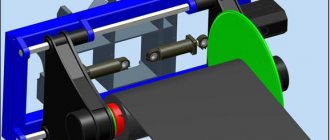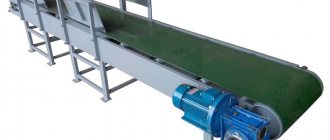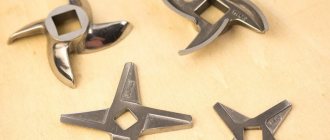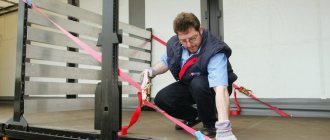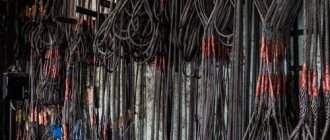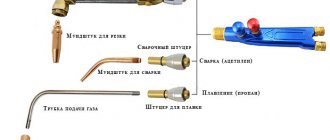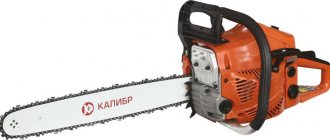Extruders are classified according to the type and type of screws used.
Single screw extruders typically have constant diameter screws, meaning the diameter of the screw is the same at the start and end.
Fig.1. Single screw extruder worm
1-cylinder, 2-worm core, 3-worm ridge, 5-gap between worm and cylinder, 4-worm wall.
D-screw diameter, Dc-core diameter, h-ridge height, w-channel width, δ-gap between the ridge and the inner surface of the cylinder, t-cutting pitch, e-ridge width.
The diameter of the auger (worm) D is the value of the diameter together with the ridges. All other geometric characteristics of the screw are associated with the diameter of the worm D.
The thickness of the worm coil is 0.08-0.12D for plastic processing and 0.06-0.08D for processing rubber compounds, the helix pitch is 0.7-1.5D and 0.4-0.6D, respectively
a B C)
Fig.2. Screw pairs of extruders:
a) single screw extruder, twin screw extruder b) parallel screw extruder c) screws for conical extruder
The main working body (heart) of a screw extruder is a screw pair: screw (screws) + cylinder. If we talk about multi-screw extruders, for example, about twin-screw conical extruders, then the housing in which the screw rotates can no longer be called a cylinder from the point of view of geometry, but the term is traditionally preserved.
A screw conveyor is... What is a screw conveyor?
Screw conveyor (a. screw conveyor; n. Schneckeforderer; f. convoyeur a vis, vis transporteuse, couloir helicoidal; i. transportadora de tornillo sin fin, transportador helicoidal, transportador de espiral) - a type of conveyor whose operating principle is based on moving bulk cargo with a rotating auger (screw) along a horizontal or inclined closed chute. Sh. k. - a type of transport. continuous machines. The first attempts to use augers to transport bulk cargo date back to the 16th and 17th centuries. Sh.k. with spiral blades began to be used in industry. conditions in the USA in 1887. Scope of modern. Sh.k. - transportation over short distances of dust- and gas-forming, as well as hot bulk cargoes for enrichment. f-kah. Sh. k. are often performed both transp. and technol. functions - simultaneous movement and mixing of bulk cargo. Sh. k. are also used as feeders in pneumatic and hydraulic loading devices. and other transport installations. Screw conveyor: 1 - electric motor; 2 - gearbox; 3 - gutter; 4 — outboard bearing; 5 - auger; 6 — loading pipe; 7 — unloading pipe. Sh. k. (Fig.) consists of a fixed closed chute, inside of which there is an auger supported by hanging bearings. The load entering through the loading pipe is moved forward by the rotating auger blades along the axis of the chute. Unloading is carried out through a special branch pipes (can be installed at any point along the length of the conveyor). The auger blades are usually made solid (for transporting powder and granular light-bulk cargoes), less often - tape-shaped (for small pieces) and in the form of blades separately mounted on the shaft (for caking cargoes). Screw diameter 100-600 mm, rotation speed 10-50 min-1. The Sh. K. gutter is collected from the dep. sections long 2000-4000 mm and closed with removable lids. Sections of the auger shaft corresponding in length to the sections of the chute are connected using couplings or journals supported by intermediate bearings. The head bearing is designed as a thrust bearing to absorb axial loads. The total length of the roller is up to 60 m, productivity is up to 150 t/h. Advantages of Sh. K.: simplicity of design and small size, low cost, transportation of goods in closed chutes with insignificant. dust formation, safety in operation and maintenance. Disadvantages: high energy consumption, rapid wear of the auger and chute, crumbling and abrasion of the transported cargo. Yu. S. Pukhov. Mountain encyclopedia. - M.: Soviet Encyclopedia. Edited by E. A. Kozlovsky. 1984-1991.
- Auger drilling
- Shokshinskoye field
See what “Screw conveyor” is in other dictionaries:
- screw conveyor - sraigtinis konvejeris statusas T sritis automatika atitikmenys: engl. Archimedean screw; helical conveyor; helical screw conveyor; helicoid conveyor; screw conveyer; screw conveyor; spiral conveyor vok. Archimedesche Schraube, f; Förderschnecke,… … Automatikos terminų žodynas
- screw [screw] conveyor - auger - [https://slovarionline.ru/anglo russkiy slovar neftegazovoy promyishlennosti/] Topics oil and gas industry Synonyms auger EN screw conveyer ... Technical Translator's Guide
- Conveyor - This term has other meanings, see Conveyor (meanings). Not to be confused with Conveyor Manufacturing. Belt conveyor Conveyor (from ... Wikipedia
- Screw conveyor (screw conveyor) - a screw conveyor is a stationary transport device, the working part of which is a screw (screw), which imparts forward movement to the material. Screw conveyors are used for transporting dusty,... ...Encyclopedia of terms, definitions and explanations of building materials
- Screw Conveyor - This term has other meanings, see Auger. A screw conveyor (or screw conveyor, auger) is a transporting device for bulk, small-piece, dusty, powdery materials. The principle of operation of a screw conveyor... ... Wikipedia
- screw conveyor - sraigtinis konvejeris statusas T sritis automatika atitikmenys: engl. Archimedean screw; helical conveyor; helical screw conveyor; helicoid conveyor; screw conveyer; screw conveyor; spiral conveyor vok. Archimedesche Schraube, f; Förderschnecke,… … Automatikos terminų žodynas
- Auger (screw conveyor) - An auger (or screw conveyor) is a transport device for bulk, small-piece, dusty, powdery materials. Augers are used in enterprises producing building materials, in the feed mill, flour milling and chemical industries... ... Wikipedia
- CONVEYORS are mechanical continuous vehicles for moving various goods over short distances. Conveyors of various types are used in all industries for loading, unloading and transporting materials during the production process ... Collier's Encyclopedia
- feed shop - A - layout of the technological equipment of the KOPK 15 feed shop in standard premises; B - diagram (sectional view) of the main feed mixing production line: 1 - feeder tray for silage or haylage; 2, 3, 11, 13, 14, 15 -... ... Agriculture. Large encyclopedic dictionary
- KORMOTSEKH - in the village. X. enterprise, is intended for the preparation of wet multicomponent feed mixtures immediately before feeding them to women. K. object of the feeding area; equipment of its in-line technologies. lines are adapted for blocking with unloading ... Agricultural encyclopedic dictionary
dic.academic.ru
description and device, varieties, areas of application
In production areas, loading or unloading operations, transportation of fine and bulk materials is carried out using screw conveyors, they are also called screw conveyors. This equipment has proven itself to be trouble-free and reliable.
A screw conveyor is a continuous device, which is an open or closed chute within which a screw rotates. The auger is driven by an electric motor. Blades are used to move materials downhill or horizontally. It depends on the type of conveyor. Due to their versatility, such conveyors are widely used in industry.
Scope of application of screw conveyors
- Screw conveyors are often used in the food industry, such as bakeries, elevators, flour mills, enterprises that produce various types of cereals, pasta, breakfast cereal mixtures.
- Screw conveyors are used in the production of building materials, construction dry mixtures, in mining and engineering, as well as chemical enterprises. Wherever you need to move sand, sawdust, coal, and other bulk materials.
- In agriculture, these units are necessary for moving material intended for sowing and harvesting grain, transporting dry fertilizers, feed and mixtures for feeding birds and animals.
Varieties
There are different types of screw conveyors. They are of a closed type (pipe) or open type (gutter), and can also differ in their length or pipe diameter. They differ in the way the screw rotates, stationary and movable in the direction of rotation, low-speed and high-speed. To correctly select the right type of screw conveyor, you should take into account what materials will need to be moved, the direction, the productivity of the equipment, the distance over which it is planned to move the materials and what will serve as the receiving tray, how the materials will be loaded.
With the help of inclined units, you can save space; compared to horizontal screw conveyors with the same length, inclined conveyors take up much less space. Mobile screw conveyors have a collapsible design, they can be disassembled and transported to another place of work. All parts of the screw unit consist of separate parts, all these parts are connected to each other by flange connections. This allows you to change the length of the conveyor. The use of screw conveyors made of stainless steel in the food industry eliminates the possibility of oxidation of food products.
Closed conveyor
- A closed-type screw unit consists of a sealed pipe in which a screw is mounted. This auger rotates using an electric motor. Such augers can be solid, shaped or belt, it all depends on the type of blades. The blades determine the performance of the conveyor and the type of material to be moved by this equipment. At the end of the device, in its upper part, there is a receiving tray into which bulk materials are thrown. For safety reasons, such a tray must be equipped with a lid. Below at the other end of the conveyor there is another hole, this is the unloading pipe, and it is equipped with a valve. Holes that serve for filling bulk materials can be located at any distance of the conveyor pipe.
- Enclosed screw conveyors are waterproof as well as airtight and are therefore well suited for transporting dusty materials. They can be used both indoors and outdoors. Such equipment has high productivity and speed of movement of materials. The downside is the complexity of maintenance and repair work, because all the main mechanisms are hidden in the pipe.
Open screw conveyor
An open-type screw conveyor consists of a chute or half a pipe; a screw rotates inside the structure. There are also models of open conveyors in the form of a rectangular container. The screw blades of open conveyors, like closed ones, can be solid, shaped or belt; the screw is also driven by an electric motor. Such a conveyor is primarily suitable for indoor use in order to prevent the penetration of moisture, dust or debris into the materials being moved.
Using an open conveyor, it is recommended to move materials that are odorless and will not fly away or create dust during transportation. Unlike closed conveyors, open ones are easy to repair and maintain; all working parts are in a visible place.
tokar.guru
LLC "INDUSTRIAL EQUIPMENT PLANT "PROGRESS"
LLC "Industrial Equipment Plant "PROGRESS" is a young, dynamically developing enterprise that aims to improve the quality of equipment produced in Ukraine, thereby increasing the level of its country's industry on the world market. We provide our customers with quality products and a high level of service. We are proud of our labor potential, highly qualified specialists and are always happy to have mutually beneficial cooperation!
The main range of our enterprise is: crushers: jaw, rotary, hammer, roller; screens: GIL, GIS, GIT, GVi, GVCh, GISL, GIST, GST, GK, analogues of foreign manufacturers such as Sandvik, Metso, etc.; grate screen feeders for primary screening; feeders: plate, swing, vibrating, conveyor; feeders / sluice gates series: ShP-M, Sh3, Sh5, Sh7, DRTs, RZ-BSHP, RZ-BSHZ, R3-BSHM; magnetic separators of the following types: EP, P, EPS, Sezh, PS, ZsvEm ShE, Sh, PES, BM, KM, ESZSh; vulcanizers for repair and joining of rubber-fabric conveyor belts of the VIKL, VKLP and AVU series for cables; mine grain dryers from 3t/h to 100t/h; drying drums: SB-1, SB-2, SB-3, SB-4, SB-5, etc.; cyclones; inclined bucket elevators, belt elevators, chain elevators, etc.; belt conveyors (belt conveyors); screw conveyors – screw conveyors – screw mixers; unloaders of railway cars, pick-up and loader of grain crops; scraper conveyors - conveyors; spiral classifiers; straight roller conveyors, rotary roller conveyors; roller supports, conveyor rollers; sifting surfaces (screen sieves); We also offer equipment after a major overhaul, warranty from 3 to 12 months, in stock and on order; engineering services together with Trade and Industrial Investment Center LLC, namely: design of production lines for the processing of minerals, dumps of metallurgical production, coal waste heaps, cement plants, dry construction mixture plants, etc.
Advantages of working with us: High quality and large selection of equipment; System of discounts and individual approach to each client; Selection of equipment and components to solve specific production problems; A large list of spare parts in stock and minimal delivery times.
Screw conveyor or screw conveyor: operating features
Even those who are sure that they have no idea what a screw conveyor is are mistaken. Its second name is a screw conveyor, and the principle of operation resembles the operation of a meat grinder. This is where the analogy ends. This is a reliable mechanism, easy to operate and maintain. Thanks to this device, the issue of transporting raw materials at enterprises from the construction and chemical industries to the cereal and fat-and-oil industries has been resolved.
The relatively low cost has made screw conveyors very popular. In order to increase its service life, you need to know the design features, its strengths and weaknesses. Let's talk about them.
Screw conveyor: diagram, classification, features
A screw conveyor is a device for transporting goods. Its working mechanism is a screw. As a result of its rotation (at an angle or horizontally), flour, sand, sawdust, rocks, and chemical materials are moved.
The first conveyors with spiral blades began to be used in industry at the end of the 19th century in the USA. At the same time, references to moving goods using an auger date back to the 16-17th century.
The apparatus is designed to meet the needs of production. However, the basic structure of all conveyors is similar. This is a stationary closed chute, inside of which there is an auger (screw) secured by hanging bearings. It is driven by a motor (usually powered by an electrical network).
To put it simply, the principle of operation of the conveyor looks like this.
Cargo → loading pipe → conveyor chute → auger rotating from the drive → outlet pipe.
Screw conveyors differ in the type of chute inclination.
There are:
- horizontal;
- vertical;
- inclined (up to 45 degrees).
The efficiency of transportation depends on the design of the propeller, its diameter, the direction of the spiral (right or left-handed) and the pitch. Productivity is calculated using the formula. The type of auger is selected according to the type of cargo.
- With a continuous surface. Used when moving dry, fine-grained and powdery products that are not prone to caking.
- With tape, blade and shaped. For moving compacted loads. Paddle and shaped are also used for mixing them.
The lighter the material being moved, the larger the pitch of the screw in the conveyor.
Recommendations for operating the screw conveyor
In order for the operation of the equipment to subsequently bring the expected economic effect, you need to correctly draw up the technical specifications for its production.
Barion LLC designers will take into account all the subtleties of using the conveyor, make correct calculations, and select the optimal material for its manufacture. Most often, stainless or carbon steel is used for screws.
The customer of the equipment approves the technical specifications for the production of the conveyor and the drawing attached to it. Coordinates with the manufacturer the terms of delivery and installation of equipment.
The choice in favor of a screw conveyor is obvious if you know its advantages:
- small sizes;
- simple design;
- tightness when transporting small cargo;
- affordable price;
- ease of maintenance;
- no moving parts outside.
Although these units also have disadvantages, knowing and taking them into account, you can extend the service life of the screw conveyor.
- Significant power consumption;
- short working surface length;
- partial crushing of cargo;
- rapid wear of the auger and the chute itself (especially when transporting abrasive loads).
It is equally important not to neglect scheduled and preventive maintenance of units. To extend the life of conveyors, the most wearable elements are treated with anti-corrosion and anti-static coatings. Equipment maintenance is trusted to professionals.
barion-ua.com
Application of screws
Installation diagram for concrete production using a screw.
The cement screw is used in small, medium and large production. The concrete industry has been actively using screw conveyors for a long time. This avoids many inconveniences. Since the unit is easy to use, made from a small number of simple parts, it is also very easy to maintain and use. Cement screws come in different lengths. It is thanks to its simple design that the user can always increase or decrease the conveyor to the desired length. On the market, many manufacturers offer ready-made conveyor systems based on screws of various lengths. However, you can always order a cement screw taking into account future production growth. The standard shelf life for screw conveyors is one year. However, many large enterprises, observing the operating conditions of the equipment, can boast of exceeding this period many times over.
Augers are simple and reliable and, if handled carefully, can serve their owners well for many decades.
Screw conveyor
A screw conveyor, otherwise called a screw conveyor, is designed to move materials of bulk, dusty, powdery consistency or fine-grained materials (fraction size does not exceed 20 mm). With the help of such equipment, grain, sugar, flour, sand, lime, cement, sludge, sawdust, metal shavings, chemical materials, etc. are transported. Movement is carried out in three positions: horizontal, vertical and inclined, with an inclination angle of up to 20°.
Characteristics of screw conveyors
Screw conveyors come in different lengths - from several meters to tens of meters (usually horizontal up to 40 m, and vertical up to 30 m) and have different electric motor power - from 1.5 to 55 kW. This equipment is very popular due to its ease of design and maintenance, overall dimensions, the ability to move materials in a sealed state without contact with the environment, and the convenient process of intermediate unloading. The disadvantages include high energy consumption, high wear rates of the screw and chute, and increased abrasion of the transported material.
Application of screw conveyors
There are a number of areas in which screw conveyors are used: agricultural enterprises, large production complexes and processing plants, warehouses. For example, screw conveyors are used in the process of loading operations at granaries, grain elevators and mill enterprises, cereal factories, sugar factories, etc. To produce equipment used in food industry enterprises, stainless steel and technical polymers are used, which prevent the oxidation of transported products.
They are also installed in the premises of flour mills and bakeries, feed factories, etc. for transporting raw materials within workshops. Not a single large enterprise in the chemical, coal, or mining industries can do without such equipment. Screw conveyors transport raw materials at enterprises producing building materials and mixtures and in machine-building shops. It is not recommended to use such equipment for transporting materials with a sticky consistency, dense or highly abrasive materials.
Screw conveyor - design and device
The design of the screw conveyor may vary depending on the model, but the operating principle is the same. The installed helical screw moves the loaded material as a result of its rotation. The device is powered by turning on an electric motor. The design is also equipped with a gearbox and drive shaft, which are responsible for transmitting traction force. The efficiency of the material transportation process depends on the design of the installed propeller (bladed, belt, solid or shaped), its diameter and pitch variability. The shape of the screw matches the type of load being moved. The direction of the spiral (left- or right-handed) also affects the performance of the conveyor. Augers can withstand high loads and intensive work, but the conveyor model must be selected based on the type of material being transported.
Cylindrical screw conveyors have a modular structure that allows you to adjust the length of the equipment. The housing modules are fastened to each other using intermediate flanges, and the installation of intermediate supports makes it possible to extend the spiral. Troughed conveyors have a sectional body, the length of which can be increased in accordance with production needs. Such equipment is equipped with intermediate supports and couplings.
promplace.ru
Information
- download the questionnaire and send it to
- Prices for warehouse items
- Data sheet for ES brand screw conveyors, pdf
Options for manufactured ES augers (detailed descriptions, installation drawings and much more are in the file describing the ES augers):
- 1. Inner diameter – 114mm, 139mm, 168mm, 193mm, 219mm, 273mm, 323mm
- 2. Length (from the beginning of the inlet to the middle of the outlet) - 4.5m, 6m, 8m, 10m, 12m. The maximum length of the auger is about 20 meters (depending on the diameter).
In this series, the most popular models are with a diameter of 219 and 273 mm and a length from 4 to 12 meters. They are always in stock and can be shipped quickly.
Screw conveyor: classification and areas of use
A screw (screw) conveyor is a special device that serves as a transport mechanism for small-sized, bulk, powdery and dusty materials.
They are used in warehouses and at processing and procurement enterprises, as well as in many other industries. Classification of screw conveyors according to: 1. trough inclination: gently inclined, vertical, horizontal, steeply inclined; 2. variability of pitch, screw diameter; 3. direction of the screw spiral; 4. propeller components: bladed, shaped, solid, tape. Horizontal screw conveyor The main components of the conveyor: rotating screw, drive (electric motor and gearbox), drive shaft, transport screw, chute with a semi-cylindrical bottom, loading and unloading device. The load enters through the chute and slides along it using the rotation of the screw. The cargo is unloaded through an opening in the bottom, which is equipped with shutters. The conveyor screw is a spiral that can work in different directions (to the right or left). There are propellers with the following surfaces: bladed, shaped, strip, solid. Horizontal screw conveyors are mainly used for moving caking, powder, dry and fine-grained goods. Vertical screw conveyor Components: a short horizontal screw feeder (rotates in a cylindrical pipe), a suspended shaft with continuous screw turns, a separate drive (depending on the design: one or two) for the screws. The cargo is unloaded using a pipe located in the upper part of the casing (pipe). Initially, the cargo enters the lower compartment of the vertical screw of the conveyor. Vertical screw conveyors serve as installations that allow drilling wells. With their help, it is possible to transport cargo to a height of 15 m; if the cargo is fine-grained, powdery and dry materials, then the lifting height increases to 30 m (no more). Their popularity is increasing due to the fact that such conveyors are quite energy-intensive, and with their small size they are capable of performing tasks of any complexity, and with their help it is possible to unload cargo in any given direction. shneki-armata.ru
Screw conveyor
AUGER CONVEYOR (a. screw conveyor; n. Schneckeforderer; f. convoyeur a vis, vis transporteuse, сuloir heliсopdal; i. transportadora de tornillo sin fin, transportador heliсopdal, transporta-dor de espiral) is a type of conveyor, the operating principle of which is based on moving bulk cargo with a rotating auger (screw) along a horizontal or inclined closed chute. A screw conveyor is a type of continuous transport machine.
The first attempts to use augers to transport bulk cargo date back to the 16th and 17th centuries. The screw conveyor with spiral blades began to be used in industrial settings in the USA in 1887.
The scope of application of a modern screw conveyor is the short-distance transportation of dust- and gas-forming materials, as well as hot bulk cargo at processing plants. Screw conveyors often perform both transport and technological functions - simultaneous movement and mixing of bulk cargo. Screw conveyors are also used as feeders in loading devices of pneumatic, hydraulic and other transport installations.
A screw conveyor (Fig.) consists of a fixed closed chute, inside of which there is a screw supported by suspended bearings.
The load entering through the loading pipe is moved forward by the rotating auger blades along the axis of the chute. Unloading is carried out through special pipes (can be installed at any point along the length of the conveyor).
The auger blades are usually made solid (for transporting powder and granular light-bulk cargoes), less often - tape-shaped (for small pieces) and in the form of blades separately mounted on the shaft (for caking cargoes). Screw diameter 100-600 mm, rotation speed 10-50 min-1.
The chute of the screw conveyor is assembled from separate sections 2000-4000 mm long and covered with removable covers. Sections of the auger shaft corresponding in length to the sections of the chute are connected using couplings or journals supported by intermediate bearings. The head bearing is designed as a thrust bearing to absorb axial loads.
The total length of the screw conveyor is up to 60 m, productivity is up to 150 t/h.
Advantages of a screw conveyor: simplicity of design and small size, low cost, transportation of goods in closed chutes with little dust formation, safety in operation and maintenance. Disadvantages: high energy consumption, rapid wear of the auger and chute, crumbling and abrasion of the transported cargo.
www.mining-enc.ru

